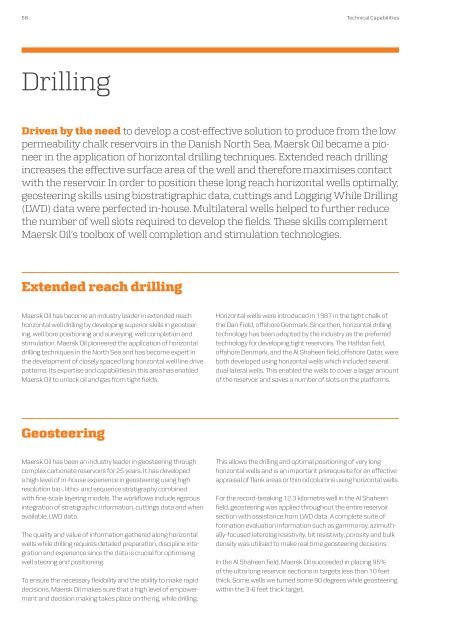Maersk Oil Company Profile
Maersk Oil Company Profile
Maersk Oil Company Profile
Create successful ePaper yourself
Turn your PDF publications into a flip-book with our unique Google optimized e-Paper software.
58 Technical Capabilities Technical Capabilities<br />
59<br />
Drilling<br />
Driven by the need to develop a cost-effective solution to produce from the low<br />
permeability chalk reservoirs in the Danish North Sea, <strong>Maersk</strong> <strong>Oil</strong> became a pioneer<br />
in the application of horizontal drilling techniques. Extended reach drilling<br />
increases the effective surface area of the well and therefore maximises contact<br />
with the reservoir. In order to position these long reach horizontal wells optimally,<br />
geosteering skills using biostratigraphic data, cuttings and Logging While Drilling<br />
(LWD) data were perfected in-house. Multilateral wells helped to further reduce<br />
the number of well slots required to develop the fields. These skills complement<br />
<strong>Maersk</strong> <strong>Oil</strong>’s toolbox of well completion and stimulation technologies.<br />
Extended reach drilling<br />
<strong>Maersk</strong> <strong>Oil</strong> has become an industry leader in extended reach<br />
horizontal well drilling by developing superior skills in geosteering,<br />
well bore positioning and surveying, well completion and<br />
stimulation. <strong>Maersk</strong> <strong>Oil</strong> pioneered the application of horizontal<br />
drilling techniques in the North Sea and has become expert in<br />
the development of closely spaced long horizontal well line drive<br />
patterns. Its expertise and capabilities in this area has enabled<br />
<strong>Maersk</strong> <strong>Oil</strong> to unlock oil and gas from tight fields.<br />
Geosteering<br />
<strong>Maersk</strong> <strong>Oil</strong> has been an industry leader in geosteering through<br />
complex carbonate reservoirs for 25 years. It has developed<br />
a high level of in-house experience in geosteering using high<br />
resolution bio-, litho- and sequence stratigraphy combined<br />
with fine-scale layering models. The workflows include rigorous<br />
integration of stratigraphic information, cuttings data and when<br />
available, LWD data.<br />
The quality and value of information gathered along horizontal<br />
wells while drilling requires detailed preparation, discipline integration<br />
and experience since the data is crucial for optimising<br />
well steering and positioning.<br />
To ensure the necessary flexibility and the ability to make rapid<br />
decisions, <strong>Maersk</strong> <strong>Oil</strong> makes sure that a high level of empowerment<br />
and decision making takes place on the rig, while drilling.<br />
Horizontal wells were introduced in 1987 in the tight chalk of<br />
the Dan Field, offshore Denmark. Since then, horizontal drilling<br />
technology has been adopted by the industry as the preferred<br />
technology for developing tight reservoirs. The Halfdan field,<br />
offshore Denmark, and the Al Shaheen field, offshore Qatar, were<br />
both developed using horizontal wells which included several<br />
dual lateral wells. This enabled the wells to cover a larger amount<br />
of the reservoir and saves a number of slots on the platforms.<br />
This allows the drilling and optimal positioning of very long<br />
horizontal wells and is an important prerequisite for an effective<br />
appraisal of flank areas or thin oil columns using horizontal wells.<br />
For the record-breaking 12.3 kilometre well in the Al Shaheen<br />
field, geosteering was applied throughout the entire reservoir<br />
section with assistance from LWD data. A complete suite of<br />
formation evaluation information such as gamma ray, azimuthally-focused<br />
laterolog resistivity, bit resistivity, porosity and bulk<br />
density was utilised to make real time geosteering decisions.<br />
In the Al Shaheen field, <strong>Maersk</strong> <strong>Oil</strong> succeeded in placing 95%<br />
of the ultra long reservoir sections in targets less than 10 feet<br />
thick. Some wells we turned some 90 degrees while geosteering<br />
within the 3-6 feet thick target.<br />
3D visualisation of the horizontal well pattern in the Al Shaheen field, offshore Qatar<br />
Multilateral wells<br />
Multilateral well technology is nothing new to the oil industry but<br />
the level of complexity has increased; especially in the functionality<br />
of well junctions. Many operators will have good production rates<br />
without performing a stimulation of their reservoirs and therefore<br />
Multilateral wells can increase reservoir contact significantly.<br />
In <strong>Maersk</strong> <strong>Oil</strong> Qatar, several Multilateral wells were drilled where<br />
barefoot holes have been stimulated prior to running the actual<br />
completion. However, with the extended reach wells drilled here, the<br />
reservoir contact is somewhat maximised by different means.<br />
Most <strong>Maersk</strong> <strong>Oil</strong> Multilateral wells in Denmark are dual-laterals.<br />
The main reason for this is to manage the risk versus reward<br />
as for each junction, the complexity increases. This is evaluated<br />
for each project or well independently. The increased cost and<br />
risk exposure are rewarded by the increased reservoir contact,<br />
which has been as much as twice the size of reservoir sections<br />
measuring around 13,000 feet.<br />
Another reason for choosing a Multilateral design could be a<br />
limitation in surface footprint or as for <strong>Maersk</strong> <strong>Oil</strong>, a limited<br />
number of slots from a certain location. It can also be a conscious<br />
economic decision when designing offshore facilities<br />
for a field development plan as it was done for Halfdan North<br />
East. Halfdan North East is a thin chalk gas reservoir that<br />
was developed with a mixture of single and dual-laterals in a<br />
spiral pattern for optimal reservoir contact. Here Multilateral<br />
technology, together with the CAJ stimulation technique was<br />
applied to target the entire reservoir from a single location.<br />
The Multilateral systems are RAM level 5 which ensures pressure<br />
integrity at the junction so each lateral can be stimulated<br />
individually.








